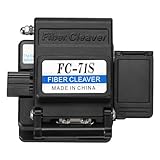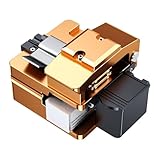20 Best Fiber Optic Cleavers of 2023 – Romance University
After hours researching and comparing all models on the market, Romance University finds out the Best Fiber Optic Cleavers of 2023. Check our ranking below.
2,903 Reviews Scanned
- PRECISE CLEAVING: Provides a cleave with a cutting angle of less than 0.5° for optimal fiber preparation for fusion splicing.
- BUILT-IN FIBER HOLDER: The fiber cleaver can hold 250µm and 900µm single fiber with a readable scale for accurate cleave lengths from 8 to 20mm.
- VERSATILE USE: Ideal for field splicing applications, splicing trucks, laboratories, fiber technicians, fiber splicers, and anyone that needs to cleave a fiber optic cable prior to performing a fusion splice.
- DURABILITY: Lightweight and rugged design increased durability. Also easy to disassemble and operate, allowing easy blade replacement.
- BLADE LIFE: 48000 times(3000*16) .
- Applicable fibers:Silica optical fiber
- Bare fiber diameter :125um
- Coating diameter:250-900um
- Cleaving angle:0.5-0.8 degrees with single fiber;Cleave Length: 9 - 16mm (Single Fiber - 0.25mm Coating) 10 - 16mm (Single Fiber - 0.9mm Coating)
- Blade life:48000 times(100*16*3)
- PRECISE CLEAVING:Provides a cleave with a cutting angle of less than 0.8° for optimal fiber preparation for fusion splicing
- BUILT-IN FIBER HOLDER:The fiber cleaver can hold 0.25mm,0.9mm and 3.0mm single fiber with a readable scale for accurate cleave lengths from 5 to 25mm
- VERSATILE USE:Ideal for field splicing applications, splicing trucks, laboratories, fiber technicians, fiber splicers, and anyone that needs to cleave a fiber optic cable prior to performing a fusion splice
- DURABILITY:Lightweight and rugged design increased durability. Also easy to disassemble and operate, allowing easy blade replacement
- Tungsten steel blade:a service life of up to 48,000 times. Automatic knife return
- High Precision Cleaves
- Compact body& light weight
- 250μm Coated or 900μm Buffer fiber
- Provides approximately 36,000 cleaves
- 12 Position Rotatable and Replicable Blade
- Ultra-Precise Cleaving Technology Engineered to deliver industry-leading <0.5° cutting angle accuracy, ensuring flawless fiber end-face preparation for seamless fusion splicing. Certified to meet IEC 61300-3-27 standards for telecom-grade performance.
- Intelligent Fiber Retention System Dual-size V-groove accommodates 250µm bare fiber & 900µm coated fiber.Precision-calibrated scale enables 8-20mm cleave length adjustments (±0.5mm tolerance). Precision-calibrated scale enables 8-20mm cleave length adjustments (±0.5mm tolerance).Anti-slip clamping mechanism prevents fiber displacement during operation.
- Multi-Application Compatibility Field service teams & mobile splicing units,Telecom infrastructure maintenance,Laboratory R&D environments,FTTH/FTTA deployment specialists,Certified fiber optic training programs.
- Military-Grade Durability Features CNC-machined aluminum alloy base with oxidation-resistant coating.Shock-absorbing polymer housing (IP54 rated).Tool-free disassembly for blade maintenance,Ergonomic thumbwheel with torque control (5-15N·m adjustable).
- Extended Blade Economics 48,000-cycle lifespan (3,000 cleaves/blade × 16 positions),Diamond-coated cutting edge maintains sharpness through 48000+ cleaves,Visual wear indicator for proactive blade rotation.
Last update on 2025-11-08 / Affiliate links / Product Titles, Images, Descriptions from Amazon Product Advertising API
How Do You Buy The Best Fiber Optic Cleavers?
Do you get stressed out thinking about shopping for a great Fiber Optic Cleavers? Do doubts keep creeping into your mind? We understand, because we’ve already gone through the whole process of researching Fiber Optic Cleavers, which is why we have assembled a comprehensive list of the greatest Fiber Optic Cleavers available in the current market. We’ve also come up with a list of questions that you probably have yourself.
Romance University has done the best we can with our thoughts and recommendations, but it’s still crucial that you do thorough research on your own for Fiber Optic Cleavers that you consider buying. Your questions might include the following:
- Is it worth buying an Fiber Optic Cleavers?
- What benefits are there with buying an Fiber Optic Cleavers?
- What factors deserve consideration when shopping for an effective Fiber Optic Cleavers?
- Why is it crucial to invest in any Fiber Optic Cleavers, much less the best one?
- Which Fiber Optic Cleavers are good in the current market?
- Where can you find information like this about Fiber Optic Cleavers?
We’re convinced that you likely have far more questions than just these regarding Fiber Optic Cleavers, and the only real way to satisfy your need for knowledge is to get information from as many reputable online sources as you possibly can.
Potential sources can include buying guides for Fiber Optic Cleavers, rating websites, word-of-mouth testimonials, online forums, and product reviews. Thorough and mindful research is crucial to making sure you get your hands on the best-possible Fiber Optic Cleavers. Make sure that you are only using trustworthy and credible websites and sources.
Romance University provides an Fiber Optic Cleavers buying guide, and the information is totally objective and authentic. We employ both AI and big data in proofreading the collected information. How did we create this buying guide? We did it using a custom-created selection of algorithms that lets us manifest a top-10 list of the best available Fiber Optic Cleavers currently available on the market.
This technology we use to assemble our list depends on a variety of factors, including but not limited to the following:
- Brand Value: Every brand of Fiber Optic Cleavers has a value all its own. Most brands offer some sort of unique selling proposition that’s supposed to bring something different to the table than their competitors.
- Features: What bells and whistles matter for an Fiber Optic Cleavers?
- Specifications: How powerful they are can be measured.
- Product Value: This simply is how much bang for the buck you get from your Fiber Optic Cleavers.
- Customer Ratings: Number ratings grade Fiber Optic Cleavers objectively.
- Customer Reviews: Closely related to ratings, these paragraphs give you first-hand and detailed information from real-world users about their Fiber Optic Cleavers.
- Product Quality: You don’t always get what you pay for with an Fiber Optic Cleavers, sometimes less, and sometimes more.
- Product Reliability: How sturdy and durable an Fiber Optic Cleavers is should be an indication of how long it will work out for you.
Romance University always remembers that maintaining Fiber Optic Cleavers information to stay current is a top priority, which is why we are constantly updating our websites. Learn more about us using online sources.
If you think that anything we present here regarding Fiber Optic Cleavers is irrelevant, incorrect, misleading, or erroneous, then please let us know promptly! We’re here for you all the time. Contact us here. Or You can read more about us to see our vision.
FAQ:
Q: Which is the best optical fiber cleaver to use?
A: Angled optical fiber cleaver Sumitomo’s FC-SE-AFC-08 angled optical fiber cleaver is a 1-step operation for easy, repeatable, and consistent eight degree cleaves for the mechanical splices and APC terminations. It has a preset 8° cleave angle without user adjustment. 80µm cladding fiber cleaver CT-38 from Fujikura
Q: How does the CT50 optical fiber Cleaver work?
A: The CT50 changes the position of the cleaving blade automatically and in response to the cleave quality of the optical fibers as seen by the fusion splicer. The fusion splicer will then rotate the blade once it deems the quality is poor. In addition, the CT50 completes cleaving of the fiber and scrap collection in the same step. 1.
Q: What causes the angle of a fiber Cleaver?
A: Any torsion of the fiber during the cleave will result in an angle as shown below. This is because a crack will propagate in a direction perpendicular to the local principal tensile stress. Torsion of the fiber causes the principal stresses of the fiber to be angled with respect to the fiber axis.
Q: What kind of Cleaver do you use in the field?
A: Corning’s FBC-002 field cleaver is a single mode and multimode cleaver that has a ceramic blade with a life of at least 1,000 cleaves. This type of cleavers do require some skill to achieve the desired angles, but its small, lightweight size makes it perfect for use in the field.





